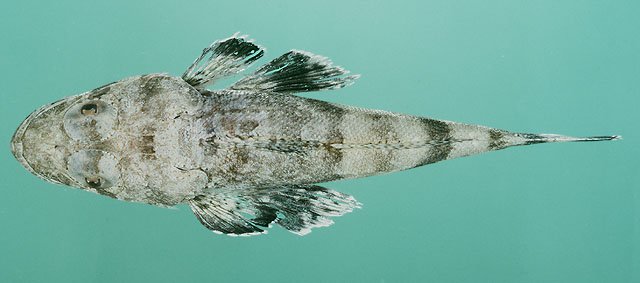| Platycephalidae (Flatheads) |
| 24 cm TL (male/unsexed) |
|
reef-associated; marine; depth range 11 - 45 m, non-migratory |
| Indo-West Pacific: Somalia, Mauritius, Seychelles, Pakistan, Sri Lanka, Maldives, Chagos Archipelago, Indonesia, Philippines, Port Moresby, northern Queensland and New Caledonia. Reported from India (Ref. 45255). |
|
Dorsal spines (total): 9-9; Dorsal soft rays (total): 11-12; Anal spines: 0-0; Anal soft rays: 11-11. Infraorbital and suborbital ridges bearing many fine serrations. Lower side of head unicarinate. Iris lappet bilobed. Caudal fin with dark basal band, whitish central band, blackish submarginal band becoming paler above, upper area usually with a few distinct dark spots.
Description: Characterized by Tan to greyish color; 7-8 blackish bars/saddles across back, dark blotches along side; first dorsal fin with large dark blotch; small ark spots on second dorsal fin; scattered dark spots on pectoral fins; dark brown to blackish pelvic fins with white margin; 1-9 anterior lateral-line scales bearing small spine; 4-5 preopercular spines, uppermost longest with an accessory spine on anterior base (Ref. 90102). |
| Taken over sand around coral reefs to depths of 11 m; one specimen taken by trawl at 45 m (Ref. 9790). Also occurs on silty sand or rubble bottoms near reefs (Ref 90102). |
|
Least Concern (LC); Date assessed: 04 March 2015 Ref. (130435)
|
| harmless |
Source and more info: www.fishbase.org. For personal, classroom, and other internal use only. Not for publication.

